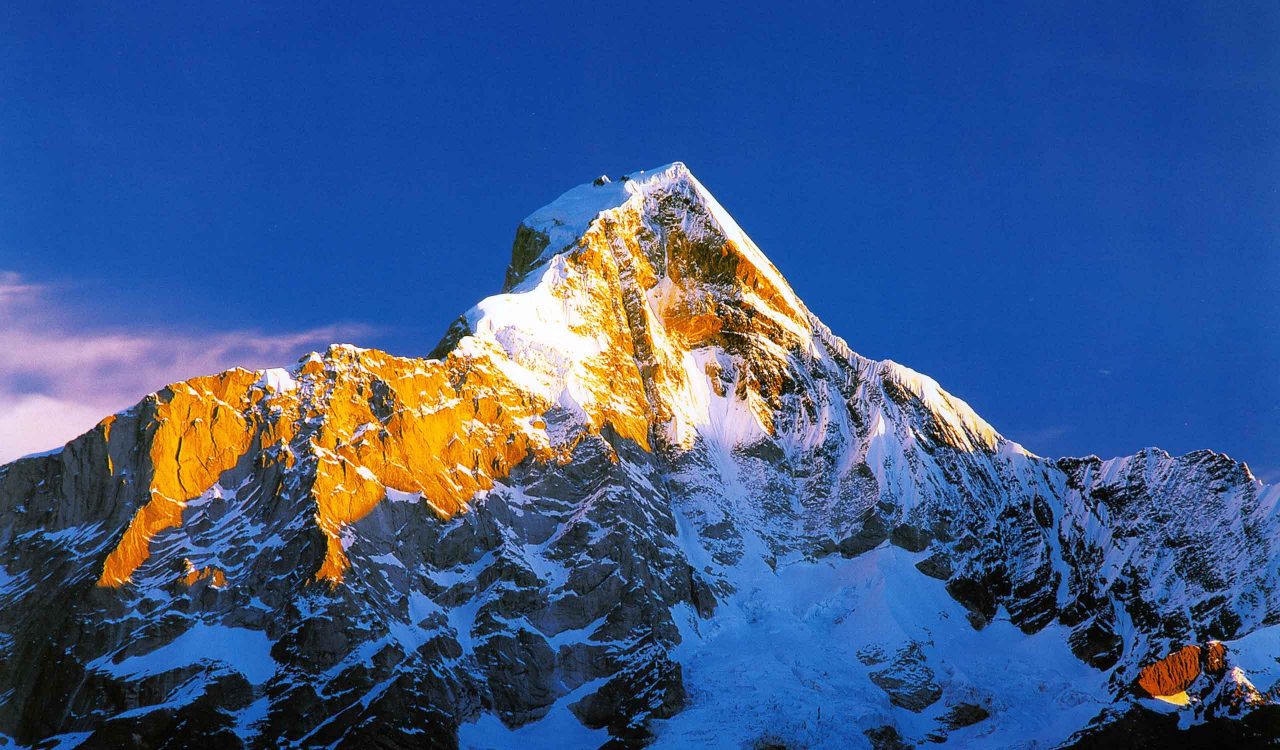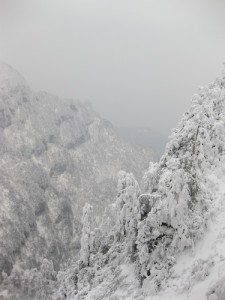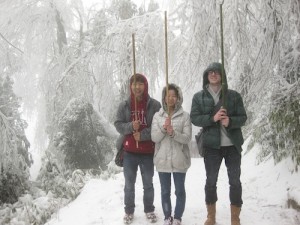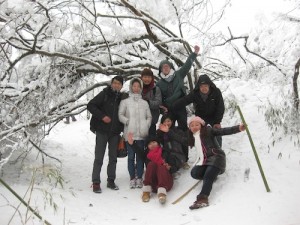Off the Beaten Track: Discover 7 Hidden Gems in Sichuan || PLUS Daniel’s Firsthand Experience
DID YOU KNOW – when you travel Sichuan it’s about much more than Chengdu, Pandas and Spicy Food.

Those three come to mind when we hear about Sichuan. But what about mountains, rolling green hills and Tibetan Culture?
If you’re hoping to get out of Chengdu for a week or two, why not find out what wider Sichuan has to offer.
Perhaps Western Sichuan (川西, chuānxī) filled with snow mountains, awesome day (or longer) hikes, and a glimpse into Tibetan culture.
Travelling around Sichuan is a great adventure, here are 7 spots we think you simply have to visit at some point.
Travel Sichuan #1 – Four Sister Mountain
Travel Sichuan #2 – Dānbā
Travel Sichuan #3 – Gānzī
Travel Sichuan #4 – Yaqing Temple
Travel Sichuan #5 – Lǐtáng
Travel Sichuan #6 – Yading National Nature Reserve
Travel Sichuan #7 – Kāngdìng
BONUS – Daniel’s Story
Travel Sichuan || Four Sister Mountain – Sìgūniángshān 四姑娘山
This is the most accessible place in Western Sichuan to travel from Chengdu, with just a 4-5 bus journey from the city.
Here you’ll have your choice of various trails to take.
There are three most famous valleys to trek through to catch a glimpse of the peaks, ranked from easiest to hardest:
- Shuangqiao Valley (双桥沟, Shuāngqiáo Gōu)
- Changping Valley (长坪沟, Chángpíng Gōu)
- Haizi Valley (海子沟, Hǎizi Gōu).
Shuāngqiáo is a good option for those who just want to enjoy the snow mountains but don’t want to walk too much – there are shuttle buses in this area of the park.
Chángpíng is a good fit for those wanting to get a bit of exercise with a half-day hike, while Hǎizi Valley will take most travellers the whole day – don’t forget to bring lunch, snacks, & water on either of these.

If you are looking for bigger physical challenges, many local guides arrange group treks to one of the four (sister) peaks.
This is a several day undertaking and ascent to the peak largely depends on weather conditions.
Note that in the town at the foot of the peaks, altitude is about 3000+ m.
For those who are not physically in shape, these hikes may be more challenging.
Travel Sichuan || Dānbā 丹巴
We delve deeper now as we travel Sichuan further.
A several-hour drive from the towns next to Four Sister Park is Danba, a small town that is the capital of the Aba Tibetan & Qiang Autonomous Prefecture (阿坝藏族羌族自治州, Ābà Zàngzú Qiángzú Zìzhìzhōu).
The surrounding area is worth exploring, known for watchtowers in its hills, which range from 300 to 1500 years old.

While Jiaju (甲居藏寨, Jiǎjū Zàngzhài) is the more famous area for them and has more infrastructure for tourists (as well as ticketed areas), Zhonglu (中路藏寨, Zhōnglù Zàngzhài) is the more off-the-beaten track option.
If you come in the summertime, you’ll can have your fill of plums and apricots right the tree.
If ancient watchtowers, green, rolling hills, and delicious fruits don’t entice you, you should visit this area just for the opportunity to stay at a guesthouse run by a local Tibetan family.
From Dānbā, you can head to Gānzī, a county town, that is a good jumping off point for visiting more culturally Tibetan parts of Sichuan.
That leads us nicely onto #3…
Travel Sichuan || Gānzī 甘孜
Ganzi Town (甘孜镇, Gānzī Zhèn), or Garze (Tibetan) town, the seat of Ganzi Tibetan Autonomous Prefecture, is usually a transfer point for trips to Sèdá (色达), which is home to largest Tibetan Buddhist institute in the world.
At time of writing, foreign visitors are not allowed in Seda.
Ganzi Town also has a couple of Tibetan temples you can visit, one being:
Yaqing Temple – Yàqīngsì 亚青寺
Foreign visitors, though, can visit Yaqing Temple, a Buddhist monastery complex.
With 10,000 members, it has the largest concentration of monks and nuns in the world.
At an altitude of 3800 meters, this temple is split up into two sections: temple buildings for the general public, and in the middle is an island of accommodation for the temple’s nuns (only women are allowed to walk through).

The mix of nature and religion, modern and ancient here is astounding.
As you walk through the temple, you observe followers reciting chants as they spin Tibetan prayer wheels.
You’re surrounded by snow mountains on all sides, as you examine the nun’s accommodation, a collection of rather slapdash-looking houses.
The colour that will stay in your mind, as many of the buildings of painting in this color exclusive to sacred things or places in Tibetan culture.
Lǐtáng 理塘
Lovers of long car rides (8 hours) with switchbacks and glimpses of the areas beautiful snow mountains will enjoy the the trip to Litang, a Tibetan town – and one of the world’s highest at 4,000 meters.
Litang is home to a temple built in 1580 by the 3rd Dalai Lama.
Litang was also the birthplace to many significant figures in Tibetan Buddhism, include both the 7th and 10th Dalai Lama.

The views from hills next to the Monastery are some of the best in Western Sichuan.
You can also take trips outside of Litang to see grasslands (and yaks), watch a Tibetan sky burial, or relax in natural hot springs.
FUN FACT: Tibetan (藏语, zàngyǔ) is a language completely unintelligible from the Chinese language, although they are part of the same language family (汉藏语系, Hànzàngyǔxì).
Similar to Chinese, Tibetan contains many dialects (方言, fāngyán) that are often mutually intelligible from each other. For example, someone from Lhasa will not understand Tibetan spoken by someone in Western Sichuan.
While on your trip, it wouldn’t hurt to learn a few Tibetan words. Though you can get around pretty well with Mandarin.
Travel Sichuan || Yading National Nature Reserve – Yàdīng Guójiājí Zìrán Bǎohùqū 亚丁国家级自然保护区
Nature lovers who want to delve in Sichuan travel will enjoy the hiking at Yading National Reserve.
A two-day ticket will set travellers back 270 yuan, but with it, you can enjoy both long and short trails of the park, which include access to grasslands and views of the surrounding snow mountains.

The long trail will take you up, Milk and Five-Color Lake, at 4600-4700 m.
The water from these lakes comes from melted snow from snow mountains, giving them an eye-catching turquoise color.
The town where most accommodations and food is offered is called Shangri-La (香格里拉, Xiānggélǐlā), not to be confused with the Shangri-La in Yúnnán (although a day-long shared taxi can take you there).
Travel Sichuan || Kāngdìng 康定
The last stop on your journey through Western Sichuan on the way back to Chengdu will be Kangding.
The big draw of Kangding is its proximity to Chengdu (a 3-4 hour trip with no traffic – great for a long weekend trip), and its a great jumping off point for longer treks of snow mountains in the area.

Kangding, itself, has some short hikes within walking distance of the main part of town, to observe yaks and horses grazing through the hilltop grasslands.
BONUS – Daniel’s Story
It’s always nice to hear stories from people who have been there and done it!
Daniel is one of those people, he came to study with LTL and travelled Sichuan as well. Here is his account! Enjoy
This story was contributed by Daniel Greeves
During Chinese New Year and the week after I decided to head down to Sichuan and see some more of China.
As part of my trip I planned to scale Mount Emei (峨眉山), one of the four sacred Buddhist mountains of China.
It is traditionally regarded as the place of enlightenment of the bodhisattva Samantabhadra.
As such I was expecting a nice stroll through beautiful scenery. I never expected the path to enlightenment to have so many steps and so much snow!
Exploring China – the LTL way
There are buses that take you to different starting points on the mountain- most tourists decide to get the bus straight to the peak.

I scorned at this idea at the time but learned too late that this was probably the most sensible option.
In order to make it up the trail in a day I started walking before sunrise.
At the beginning the going was easy – a light fog, cool weather and steps of a reasonable incline.
After an hour of steps I was beginning to regret my decisions and started doubting whether my body and mind was up for another 9 hours of climbing.
I stopped for some noodles and while I was waiting for the noodles I struck up a conversation with some Chinese pilgrims.
They were happy to see a ‘foreigner’ visiting and were impressed by the progress I had made thus far.
I guess I walked faster since when climbing they would kneel, place their forehead on the ground, stand back up and continue walking after every 3 steps.
By comparison I had nothing to complain about!
I was on a tight time schedule because naturally I wanted to see the pandas the day after climbing 峨眉山, so I decided to start climbing from a third of the way up the mountain.

As I started walking again I was joined by a group of 7 young Chinese people living and working around Sichuan who had decided to check out 峨眉山 during their winter break.
They gave me renewed courage to continue with their constant “加油’s”!
Learning about what everyone did gave a welcome distraction to the climbing.
After another hour of climbing the temperature had dropped well below 0C and it started snowing.
Within the hour all the evergreens bowed under the weight of the snow and ice and arched over the pathways.
Within 2 hours we were walking ankle deep in snow. We climbed for a total of 10 hours, with a few breaks for food along the way.

Once we reached the top we were greeted by hordes of Chinese tourists playing in the snow (many Sichuanese having never seen snow before) and we decided to stay a night on the peak so we could see the sunrise in the morning.
It was at this point I regretted not having walked faster so I could have got the bus back down at the end of the day.
The outside temperature was about -15C and the inside temperature about -5C owing to the fact that places South of the Yellow River don’t have central heating.
We shared a big room of 4 beds and all just lay in bed complaining about how cold it was.
One of my favourite sentences in Chinese came in very useful: “我快要冻死了!”
Wǒ kuàiyào dòng sǐle – This means “I’m about to die/I’m freezing to death”
By the morning all the water in the room had frozen solid and I discovered a new ‘hate’: frozen socks! (I thought putting on wet socks was bad….)
We awoke for the sunrise and all got the bus back down to town together and watched as the snow dissipated the lower down the mountain we got.
In all, it was one of the most challenging holidays I have had in a while but one of the most rewarding!
I missed the pandas but I made some new QQ friends, reignited my faith in the beauty of China and am 1 sacred Buddhist Mountain down with 3 more to go!
Hiking in China – Useful Vocabulary
- 爬山 páshān – Climb a mountain
- 寺庙 sìmiào – Temple
- 山顶 shāndǐng – Mountain peak
- “加油!” jiāyóu! – “Come on!”
- 峨眉山 Éméishān – Mount Emei
- “我快要冻死了!” Wǒ kuàiyào dòng sǐle! – “I’m freezing to death!”

Transport in Chinese 🚚 Your Complete Guide to 37 Forms of Transport
37 Forms of Transportation in Chinese || Plus FREE Vocab Quiz! Ready to learn about transport in Chinese? Choo, choo… here comes another vocabulary blog. In today’s edition we focus on all forms of transport in Chinese. We aren’t just…
Final Tips for Sichuan Travel
- Western Sichuan is deceivingly large. Distances given on map apps like Bǎidù (百度) or Gāodé (高德) won’t take into account the extra time it takes to go up switchback-filled mountain roads or the landslides that block roads in the summer. Always account for extra travel time.
- Because of the altitude, even in the summer, Western Sichuan is quite chilly. Bring warm clothes!
- For long hiking days, you can pick up self-heating rice dishes (自热饭, zìrèfàn). It will fill you up and warm you up.
- Summer is rainy season in Western Sichuan. If you go, clouds may cover up some of those beautiful snow mountains. Prepare for rain!
- Western toilets are very, very rare in Western Sichuan and sanitations standards are very nothing like you’ll find in cities like Chengdu, Beijing, or Shanghai. Be prepared and bring your own toilet paper.
- Many Chinese tourists will opt to drive around this area (自驾行, zìjiàxíng), normally on the way to Tibet (Xīzàng, 西藏). This means you may be able to catch a ride around many locations. Remember that foreign travellers need a permit to get into Tibet proper.
- Must try foods, include Tibetan yogurt, yak (牦牛肉, máoniúròu) in any form (dried, stir-fried, etc.), beef noodles (牛肉面, niúròumiàn), or momo (Tibetan dumplings).

Have you travelled Sichuan before? What did you think? Tell us in the comment section below.
Travel Sichuan – FAQ’s
Where is Sichuan?
Right in the centre of China. Sichuan is a big province.
It’s central location means it borders 7 other provinces of China.
What is the capital of Sichuan?
The capital city of Sichuan is Chengdu.
What is the weather like in Sichuan?
The weather in Sichuan tends to have four very distinctive seasons:
Spring – short and warm
Summer – hot and looooong
Autumn/Fall – cool and rainy
Winter – cold and foggy
What is Sichuan most famous for?
Sichuan is famous for Chengdu which in turn means the pandas, but mainly Sichuan is the home of spicy food in China.
In fact the food of Sichuan is the spiciest in the whole country.
What are the must-visit attractions in Sichuan for travelers?
Sichuan boasts a wealth of attractions that cater to different interests. Jiuzhaigou Valley‘s breathtaking lakes and waterfalls, the Leshan Giant Buddha‘s monumental charm, and the serene Mount Emei for hikers are just a few highlights.
And of course- don’t miss the chance to witness adorable pandas at the Panda Breeding Research Base!
Want more from LTL?
If you wish to hear more from LTL Mandarin School why not join our mailing list? We give plenty of handy information on learning Chinese, useful apps to learn the language and everything going on at our LTL schools!
Sign up below and become part of our ever-growing community!
BONUS || Want to study Chinese with us in Chengdu? Why not check out our group courses or individual Chinese classes.

 Hi, my name is Sabatino. I am from Italy and I am a Student Advisor at LTL. Fancy coming to study with us in China?
Hi, my name is Sabatino. I am from Italy and I am a Student Advisor at LTL. Fancy coming to study with us in China? Hi, my name is Mojca. I am from Slovenia in Europe and I work as a student advisor at our Chengdu school.
Hi, my name is Mojca. I am from Slovenia in Europe and I work as a student advisor at our Chengdu school.


